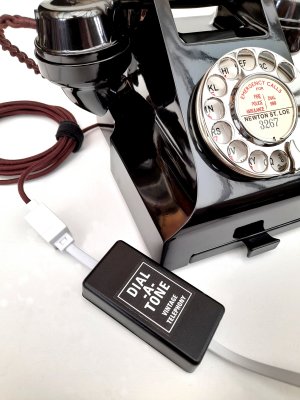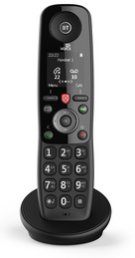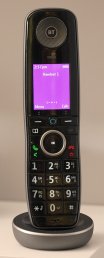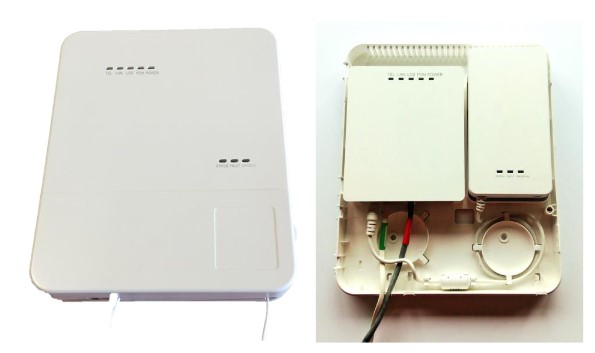BT Digital Voice (DV) | |||||||||||||||||||||||||||||||||||||||||||||||||||||||||||||||||||||||||||||||
|
The impartial information on this page is given free of charge and without
prejudice
This page only deals with BT Digital Voice but some of the information is applicable to other telecoms providers. BT intend to roll out Digital Voice to the whole of the UK by 2025. Most of the UK Telephony providers are converting their networks so they will have no copper connectivity directly connected to their exchanges. But copper wires will still exist in many places, mainly from the house to the green street cabinets. This does not mean that the copper wires to the premises will not be used. If you do not have fibre to the premises then the existing copper wires will still be used to provide the service, but these copper wires will not connect to the exchange like they used to. The copper wires will be interfaced to fibre at a green cabinet and the fibre will then be fed into the BT IP network. BT and other similar providers did this to reduce the cost of replacing the local exchanges and instead chose just to route data traffic to remote switching centres. Please beware, because the customer is now lumbered with having to power all the equipment in their home, that in the event of a power outage no 999 or 112 emergency services will be available. Ofcom have stipulated that those who are vulnerable or have emergency call devices should be supplied with a 1 hour battery backup, free of charge. BT will try to charge for these devices so fight your case and complain to Ofcom if BT refuse to supply one. If you have no mobile service in your home then your supplier should provide a resilient service. Please contact your supplier about this. Another point to remember is that if you have specialist devices connected to your line, like burglar alarms or emergency call buttons, then you must contact your supplier to advise you are moving to the new Digital service. Not all these devices will work and only your supplier will know what to advise. No matter if you are on fibre, broadband or just have a telephone line only, you will be provided with a hub/router from BT or your service provider. These have an integral telephone socket which will provide dial tone. The BT Hub only supports Tone (MF) dialling and will not support a dial telephone. Click here if you have a dial telephone. Your original master socket will either be made redundant (if the installation is fibre to the premises) or will connect to the hub only (if a non-fibre to the premises installation). BT will now retain ownership of the Smart Hub they provide. If you move to another provider then the BT Hub will have to be returned to BT, but it also means that if the hub goes faulty then BT have the responsibility of replacing it free of charge. BT are now threatening to charge high prices for equipment not returned. But be aware that the install will look a mess if on show in your living room, with the Fibre install looking awful. This is due to the number of power and connecting cables involved. Make sure they are in a cupboard or loft space if possible, with power available as well. Click here for a hardware review. The system will provide you with two exchange lines, albeit on the same number. This means that two people can dial out at the same time or receive two incoming calls at the same time, but only two calls in total. This can be changed to one line only if you do not like it, but be aware as two lines is the default. Deactivation is described in the next paragraph. Because you have two lines, the Call Waiting function is pre-enabled. Call Waiting tells you when other callers are trying to get through, whilst you are on the line. You'll hear a discreet beep when someone is trying to get through to you while you're on the phone. You can choose whether or not to take the call. On most DECT handsets the R button can be used to answer the second call. To deactivate this function you will have to call BT or manage it via your BT online account by logging in and then click on My BT - Your Products - Digital Voice - Call Waiting. It is a zero cost option. The feature can also be deactivated by using a Digital Voice handset and changing the call features to from Multiple to Single. Another major change for users is that you have to include the national area dialling code for ALL outgoing calls, including local calls. Please be aware that Voicemail is pre-enabled for Digital Voice customers. If you still wish to use your original answering machine, or do not want an answering service, then you must disable the Digital Voice voicemail. There are two ways to do this. Call BT and ask them to cease the Voicemail or login to your BT online account. The account option is best as the voice is removed straight away. Login and then click on My BT - Your products - Digital Voice - Voicemail essentials. It is a zero cost option.
Fault finding on Digital Voice BT Digital Voice Features and User Guide - Using a basic telephone BT Digital Voice Advanced Home Phone User Guide - Using a BT Wireless telephone BT Digital Voice guide on how to register a DECT/Wireless phone Virgin Media Features and User Guide Types of service and connectivity Telephone Line only BT will also provide a Digital Voice Adapter (these were free of charge) which will allow the phone to be placed in another position within your premises. This adapter requires a mains power socket nearby. BT will supply a cordless phone that connects to the hub, if
requested. These were supplied free at first but are now charged for.
The original Master socket will still be used (or upgraded) but will provide Broadband only. The cable that connects from the Master socket to the Broadband socket on a Smart Hub 2 is non-standard, as it has a non-standard RJ45 connector on the hub. The telephone line is now presented on the rear of the hub and is MF (tone) dialling only. It will not support a dial telephone. Click here if you have a dial telephone. The line socket on the rear of the Smart Hub can be connected to your existing house telephone wiring if required - click here for details. The Smart Hub is mains powered and requires a mains power socket nearby. BT will also provide a Digital Voice Adapter (these were free of charge) which will allow a phone to be placed in another position within your premises. This adapter requires a mains socket. BT will supply a cordless phone that connects to the hub, if requested. These were supplied free at first but are now charged for. Try Ebay or similar selling platforms for these cordless phones at reasonable prices.
Click here for a pictorial overview Fibre to the Premises (FTTP) and Telephone line
The BT equipment supplied at an FTTP installation require 2 mains power socket outlets. The BT Smart Hub has 4 network ports (RJ45) and a telephone socket. The telephone socket can be connected to your existing house telephone wiring - click here for details. This socket will allow only Tone (MF) dialling - and will not support a dial telephone. Click here if you have a dial telephone. BT will, if asked, supply an Digital Voice analogue adapter and a Digital Voice telephone or two Digital Voice telephones. The digital adapter allows an analogue telephone to be connected at a remote location. The adapter is DECT based and requires a mains socket. This adaptor will only support Tone (MF) dialling and will not allow a dial telephone to dial out. Click here if you have a dial telephone. The Digital Voice telephones supplied by BT are cordless DECT telephones. These were supplied free at first but are now charged for. Click here for more information on how to use DECT with the Smart Hub Click here for a pictorial overview Technical Information Wiring the Hub telephone socket to house
wiring If you wish to connect your house wiring to the hub then the house wiring MUST be disconnected from the master socket (NTE). This is essential and if you do not feel confident about this then call an expert. Do not just plug a cable into the front socket on the Master Socket and the other end into the telephone socket in the back of the Smart Hub! Click here for instructions on connecting your house wiring to the Smart Hub
A maximum of five DECT cordless devices can be connected to the hub. Click here for the BT statement - at the end of the video Numerous DECT devices can be connected to the hub including other makes of DECT telephone. The PIN is 0000. An important point to remember is that DECT is similar to WiFi in so much as it has a range which can change depending on the building. In some cases no signal may reach your phone and the only way to remedy this would be to use a DECT repeater device. BT have advised that the Smart Hub 2 does NOT support DECT repeaters (Feb 2022). Click here for a work around To see what DECT devices are connected, log into the BT Smart Hub 2 Manager (the login/password information is on the rear of the hub). Navigate to the Phone section, which is found to the left of the home page.
BT Digital Voice Adapter Linking to the hub:-
Phones that work with Dials or early
keypads So what to do - you need to purchase a Dial Pulse to MF converter. These converters can be used in a number of ways:-
There are a number of converters to be found, but be careful as some of these require special wiring into the phone or need a power supply. It is better to buy a self contained converter and there is one called the Dial-A-Tone. This dialler will convert the dial pulses produced by the phone into tones, which will be recognised by the new equipment and does not require a power supply. This type is available from a company called Vintage Telephony. This link takes you directly to the Dial-A-Tone page https://www.vintagetelephony.co.uk/product/pulse-to-tone-converter-voip-bt-digital-voice-dial-a-tone. This web site has no connection with this company.
BT Digital Voice Handsets These handsets are powered by batteries and are supplied with a charger which requires connection to a mains socket. With a new telephone, pull out the plastic tab on the base of the telephone to engage the batteries. Then plug the charger into a mains socket and then place the phone in the charger. Leave on charge initially for a minimum of 16 hours. Linking new phones to the Smart Hub:-
These handsets have the ability to store contact names and numbers, but please beware that this information is stored on the Smart Hub and not the telephone. This causes a problem if you either change or default the Smart Hub as the stored information will be lost. Click here on how to back up contact information. These telephones also support more than one handset on the same call, known as conference. With these handsets the function "Auto Join" needs to be activated. Go to - Settings - Line Settings - Calls Settings - Auto Join Calls - toggle this to on and Save. The User Guide tells you this but does not tell you how to use the function. To join a call in progress, press the green talk button and get dial tone - the display says "Join Call" - press the right hand option button. These handsets were supplied free by BT at first but are now charged for, so shop around for some good prices. For more information on these phones please visit the BT web site. BT guide on how to register a DECT phone Overview of both DV Telephones
Frequently asked questions Q. How many telephone can be connected to the
telephone port on the back of the Smart Hub 2? Q. The installation looks like a mess, I don't want
it on show or in my living room. What can I do? The equipment is best in a cupboard, out of the way. The best option is to get the supplier to run the external cable into the loft and then drop it down, through the ceiling, into a cupboard or at a high level on a wall. Remember that you also require mains power at that point. Most people today use WiFi so the position in most modern houses will be good no matter where placed. The thick walls of older houses and stone built cottages appear to reduce WiFi coverage so carful consideration of position is called for. If WiFi is a problem then locate the hub as central as possible in the house. Q. I have a number of sockets already and still
wish to use them. Q. I am using an old phone and it doesn't ring
since Digital Voice was fitted. Q. I have a bell in my house. Will it still work? Q. I have a dial phone. Will that work on the
new system? Q. I have my telephone line from BT and my broadband
from another company. How will that work? Q. If I use a VOIP telephone service can I still
use my old phones? Q. Can SIP devices be connected to a BT Smart Hub Q. How many DECT wireless telephones can I connect to
the Smart Hub 2? Q. My wireless DECT phones do not work in certain parts
of my house - can the coverage be extended?
Q. Do I have to use BT supplied telephones? Q. What about answering machines? Q. Do the BT supplied telephones have a Conference
function Q People complain that they leave voicemails and
that I do
not reply to them. To get the BT Voicemail deactivated you either have to call BT or logon to your BT account. The BT account way is well painful - follow these instructions:- Once logged in My BT - choose My BT - Your Products - Manage - VoiceMail - choose cancel service - follow the instructions - this is a free sales order. Q. Can I reach the messages on the BT Digital Voice
Voicemail when away from home? Q. How do I switch off the Voicemail on EE 1571, so
I can use my own Answer machine? Q. How do I switch off Virgin 1571 Voicemail? Q. My WiFi does not go very far? Q. I use my old DECT wireless system and phones and
cannot see the calling number. Q. I have a phone which has stopped working -
what do I do? Q. Can I backup the Smart Hub data and the
telephone contacts directory? Q. The white BT wall box (ONT - Optical Network
Termination Device) that connects to my Smart Hub has a red light showing
stating a fault - why is this as the phone and internet work fine?
1+1 ONT Before working on the battery unit ensure that the power is switched off to the ONT and that the battery lead is removed from the ONT. The ONT cover consists of two cover parts which are hinged on the left. The bottom cover opens by just pulling on the right hand side side. The top cover is fixed by a single Philips screw which will now be visible. It is to the right and just under the top door - you can see the screw hole in the picture to the right. With the screw removed the cover will require a good pull to open. With both covers open, the battery unit can be seen to the top right of the picture with the ONT unit on the top left. To remove the battery pack, slide the battery unit upwards and lift off the locators. On the rear of the battery box is a slide cover, which once removed exposes the four rechargeable AA batteries. Unsure they are replaced with the same rechargeable type. Do NOT, under any circumstances, use ordinary AA batteries. Some older units will have an external battery box (before April 2019). A temporary alternative to replacing batteries is to remove the Battery pack in its entirety and plug the power cable directly into the ONT. This is not advisable as batteries provide some form of mains filtering. BT advise that the battery backup unit uses four 2000 mAH-NiMH BYD rechargeable AA batteries at 1.2V.
|
|||||||||||||||||||||||||||||||||||||||||||||||||||||||||||||||||||||||||||||||
Last revised: March 18, 2025FM | |||||||||||||||||||||||||||||||||||||||||||||||||||||||||||||||||||||||||||||||
 Many people have antique telephones with dials or an early press button
telephone (with no * or #
buttons) but because the Smart Hub 2 and Digital Voice Adapters will only operate
with
tone (MF) dialling, then use of a dial is ineffective.
Many people have antique telephones with dials or an early press button
telephone (with no * or #
buttons) but because the Smart Hub 2 and Digital Voice Adapters will only operate
with
tone (MF) dialling, then use of a dial is ineffective.

